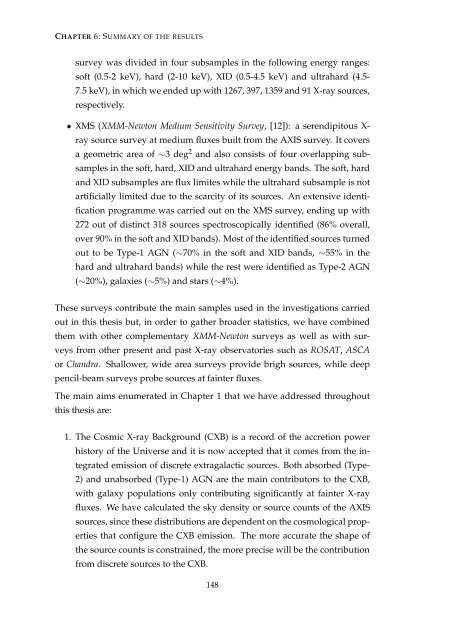pdf - SRON
pdf - SRON
pdf - SRON
You also want an ePaper? Increase the reach of your titles
YUMPU automatically turns print PDFs into web optimized ePapers that Google loves.
CHAPTER 6: SUMMARY OF THE RESULTS<br />
survey was divided in four subsamples in the following energy ranges:<br />
soft (0.5-2 keV), hard (2-10 keV), XID (0.5-4.5 keV) and ultrahard (4.5-<br />
7.5 keV), in which we ended up with 1267, 397, 1359 and 91 X-ray sources,<br />
respectively.<br />
• XMS (XMM-Newton Medium Sensitivity Survey, [12]): a serendipitous X-<br />
ray source survey at medium fluxes built from the AXIS survey. It covers<br />
a geometric area of ∼3 deg 2 and also consists of four overlapping subsamples<br />
in the soft, hard, XID and ultrahard energy bands. The soft, hard<br />
and XID subsamples are flux limites while the ultrahard subsample is not<br />
artificially limited due to the scarcity of its sources. An extensive identification<br />
programme was carried out on the XMS survey, ending up with<br />
272 out of distinct 318 sources spectroscopically identified (86% overall,<br />
over 90% in the soft and XID bands). Most of the identified sources turned<br />
out to be Type-1 AGN (∼70% in the soft and XID bands, ∼55% in the<br />
hard and ultrahard bands) while the rest were identified as Type-2 AGN<br />
(∼20%), galaxies (∼5%) and stars (∼4%).<br />
These surveys contribute the main samples used in the investigations carried<br />
out in this thesis but, in order to gather broader statistics, we have combined<br />
them with other complementary XMM-Newton surveys as well as with surveys<br />
from other present and past X-ray observatories such as ROSAT, ASCA<br />
or Chandra. Shallower, wide area surveys provide brigh sources, while deep<br />
pencil-beam surveys probe sources at fainter fluxes.<br />
The main aims enumerated in Chapter 1 that we have addressed throughout<br />
this thesis are:<br />
1. The Cosmic X-ray Background (CXB) is a record of the accretion power<br />
history of the Universe and it is now accepted that it comes from the integrated<br />
emission of discrete extragalactic sources. Both absorbed (Type-<br />
2) and unabsorbed (Type-1) AGN are the main contributors to the CXB,<br />
with galaxy populations only contributing significantly at fainter X-ray<br />
fluxes. We have calculated the sky density or source counts of the AXIS<br />
sources, since these distributions are dependent on the cosmological properties<br />
that configure the CXB emission. The more accurate the shape of<br />
the source counts is constrained, the more precise will be the contribution<br />
from discrete sources to the CXB.<br />
148
















